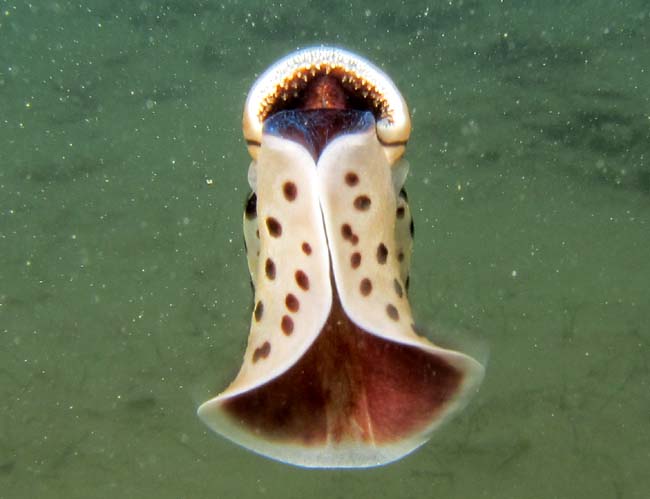This species has been observed on Reunion, Mauritius and Mayotte Islands
The dorsal surface is white to light violet with dark purple-brown to brown spots The front of the animal has a large fringed oral veil The mantle is smooth and much smaller than the body Posteriorly, the mantle folds into a relatively long siphon or tube, which allows the mantle cavity and gills to remain in contact with fresh seawater while the animal is buried in the sand. |

|
|
| Showing species characteristics... | Photo Norbert Verneau |
|
Remarks :
Identification confirmed by Nathalie Yonow
Synonymous : (according Worms)
- Oscaniopsis amboinei vayssière, 1898 - Oscaniopsis semperi Bergh, 1897
- Oscaniopsis compta Bergh, 1897 - Pleurobranchus luniceps Cuvier, 1816
Bibliographic data :
The large oral veil bears numerous small tentacular processes along the anterior margin. Larger papillae are arranged in somewhat irregular rows on the ventral surface of the oral veil
The sole of the foot and the ventral surface of the oral veil are dark purple, almost black
In most pleurobranchs the foot and mantle are of similar size but in Euselenops the foot is much larger.
No internal shell.
It can swim elegantly by flapping its foot and mantle up and down
In aquaria, this notaspidea was often observed lying upside down on the bottom. This was first interpreted as a sign of poor health, but the animals vigorously swam away upon touch, and did not appear moribund.
Lying on its back may be part of the normal behavior of E. luniceps and could be connected with food capture. When extented, the tentacles of the oral veil resemble small hydroids and could lure small prey animal to the mouth area. Bergh (1897) described finding the remnants of six small polychaete worms in the crop of his Hong Kong specimen
References :
Bill Rudman Seaslug site : Sea Slug Forum : Euselenops luniceps
Publications :
Cuvier, G.L. 1817 Le Règne Animal. Vol. 2. (Gasteropodes)., Vol. 4. (Plates) .
Jensen, K.R. The Malacofauna of Hong Kong. Sublittoral notospidea and nudibranchia (opistobranchia) from Hong Kong, with a description of a new species.
Other photos of Euselenops luniceps :
 |
Norbert Verneau
It can swim elegantly by flapping its foot and mantle up and down
|
Yann von Arnim
|
 |
 |
Maurice Jay Reunion, size : 54 mm, 45 m
|
More photos from Indian Ocean